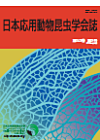巻号一覧

45 巻 (2001)
- 4 号 p. 183-
- 3 号 p. 111-
- 2 号 p. 39-
- 1 号 p. 1-
45 巻, 1 号
選択された号の論文の4件中1~4を表示しています
- |<
- <
- 1
- >
- >|
原著
-
山口 卓宏, 桐谷 圭治, 松比良 邦彦, 福田 健原稿種別: 原著
専門分野: [not specified]
2001 年 45 巻 1 号 p. 1-7
発行日: 2001年
公開日: 2003/03/25
ジャーナル フリーIn order to project the influence of global climatic changes on insects, we examined the effects of a rise in temperature of 2–3°C on the phenology and occurrence of arthropod crop pests using data obtained from Kagoshima Prefecture, southwestern Japan, in 1998. The average temperature of this year was 2°C higher than that between 1960–1998. Several arthropod species emerged earlier than previous years because of the unusually high average temperature. These species were Homona magnanima, Adoxophyes honmai, Scirtothrips dorsalis, Pseudaulacaspis pentagona, aphids (mainly Myzus persicae and Lipaphis erysimi), and Tetranychus kanzawai. All species showed developmental zeros of less than 10°C. In contrast, Spodoptera litura and Helicoverpa armigera, whose developmental zeros were above the mean winter temperature, emerged as usual in the spring. A possible increase in the number of generations per year was not clearly shown by the trap capture records, but all species are likely to have 1–2 more generations. The total number of male S. litura captured by pheromone traps in 1998 was the largest during the past 14 years. There was a positive correlation between the abundance of males and the mean annual temperatures. In contrast, H. magnanima, A. honmai and aphids were less abundant in 1998, and this occurs once per 4–10 years. No detectable difference in abundance was observed in H. armigera. We concluded that an elevation in mean temperature of 2°C would impact the phenology of insects, but the pattern of response would greatly vary among species.抄録全体を表示PDF形式でダウンロード (79K) -
百武 稔郎, 一松 時生, 水城 英一, 大庭 道夫原稿種別: 原著
専門分野: [not specified]
2001 年 45 巻 1 号 p. 9-14
発行日: 2001年
公開日: 2003/03/25
ジャーナル フリーA computer-based image processing technique was adapted for rapid screening of Bacillus thuringiensis. Sporulated colonies of the B. thuringiensis/B. cereus group were observed under a phase-contrast microscope and the images were recorded by a CCD camera. The data were converted into binary images after reducing the background noises and thickening the edge lines of spores and inclusions. Parasporal inclusions were then distinguished from spores by a difference in curvatures and sizes. The system automatically differentiated in five seconds between B. thuringiensis and B. cereus by the ratio of spores and parasporal inclusions.抄録全体を表示PDF形式でダウンロード (128K)
短報
-
昆野 安彦原稿種別: 短報
専門分野: [not specified]
2001 年 45 巻 1 号 p. 15-17
発行日: 2001年
公開日: 2003/03/25
ジャーナル フリーThe rice grasshopper, Oxya yezoensis, shows a three color polymorphism: red, green and brown. To examine the factors regulating adult color polymorphism, crosses between the three color morphs were carried out. It was shown that color polymorphism in Oxya yezoensis is partly controlled by genetic factors.抄録全体を表示PDF形式でダウンロード (45K) -
中坊 昌也, 大野 徹原稿種別: 短報
専門分野: [not specified]
2001 年 45 巻 1 号 p. 18-21
発行日: 2001年
公開日: 2003/03/25
ジャーナル フリーOrius spp. are promising natural enemies for control of thrips, harmful insect pests of vegetables. It is, however, extremely difficult to identify adult females of Orius spp. by their appearance. The composition of cuticular hydrocarbons in O. strigicollis, O. minutus and O. sauteri were analyzed by GC-MS. Major components were C27:1 and 2-MeC28 for O. strigicollis, C29:1, 2-MeC28 and 2-MeC30 for O. minutus and 2-MeC28, 2-MeC30 and C33:1+2 for O. sauteri. The unique hydrocarbons were C25:1+2 for O. strigicollis, C29:2 and 2-MeC32 for O. minutus and C33:1+2 and C35:1+2 for O. sauteri. We concluded that it is possible to identify these three species by a difference in composition of components of the cuticular hydrocarbons by GC.抄録全体を表示PDF形式でダウンロード (71K)
- |<
- <
- 1
- >
- >|